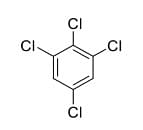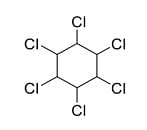In the following reaction sequence, the major product Q is
\(\text{L-Glucose}\xrightarrow[ii)Cr_2,775K,10-20 \text{atm}]{i)HI, \Delta}P\xrightarrow[UV]{Cl_2(excess)}Q\)
\(\text{L-Glucose}\xrightarrow[ii)Cr_2,775K,10-20 \text{atm}]{i)HI, \Delta}P\xrightarrow[UV]{Cl_2(excess)}Q\)
The Correct Option is D
Solution and Explanation
To solve the problem, we analyze the reaction sequence starting from L-glucose to find the major product Q.
1. Step i) Reaction with HI and heat (\(\Delta\)):
- The sugar undergoes cleavage of C-O bonds by HI.
- This reduces glucose to a mixture of iodoalkanes (polyiodo compounds).
- The carbon skeleton remains but oxygen atoms are replaced by iodine.
2. Step ii) Oxidation with Cr\(_2\)O\(_3\), high temperature and pressure:
- Iodoalkanes are oxidized to form fully chlorinated cyclic hydrocarbons (via halogen exchange).
- Oxygen atoms are removed, and the carbon framework becomes a chlorinated cyclic structure.
3. Step iii) Treatment with excess Cl\(_2\) under UV:
- Further chlorination occurs, leading to a hexachlorinated cyclohexane derivative.
4. Structure of the final product Q:
- Hexachlorocyclohexane (all positions chlorinated).
- This corresponds to structure (D).
Final Answer:
Option (D)
Top Questions on Aldehydes, Ketones and Carboxylic Acids
- Write IUPAC names of the following compounds:
(i)\; \includegraphics[height=10pt]{dummy} (ring with –CHO and adjacent –CH$_3$)
(ii)\; (CH$_3$)$_2$CHCOCH(CH$_3$)$_2$
(iii)\; CH$_3$CH(OCH$_3$)CHO
(iv)\; HOOC–(CH$_2$)$_4$–COOH
(v)\; \includegraphics[height=10pt]{dummy} (benzene–CH$_2$COOH)- UP Board XII - 2025
- Chemistry
- Aldehydes, Ketones and Carboxylic Acids
- Answer the following questions:
(i) Draw structure of the methyl hemiactetal of methanal.
(ii) There are two -NH$_2$ groups in semicarbazide. However, only one is involved in the formation of semicarbazones. Give reason.
(iii) How will you convert ethanol to 3-hydroxybutanal?- CBSE CLASS XII - 2025
- Chemistry
- Aldehydes, Ketones and Carboxylic Acids
- An organic compound (X) having molecular formula C$_5$H$_10$O can show various properties depending on its structures. Draw each of the structures if it:
(I) shows Cannizzaro reaction.
(II) reduces Tollens' reagent and has a chiral carbon.
(III) gives positive iodoform test.- CBSE CLASS XII - 2025
- Chemistry
- Aldehydes, Ketones and Carboxylic Acids
In the given reaction sequence, the structure of Y would be:

- CBSE CLASS XII - 2025
- Chemistry
- Aldehydes, Ketones and Carboxylic Acids
- What do you understand by these following terms? Give one example of each.
(i) Aldol (ii) Schiff's base (iii) Cannizaro's reaction (iv) Oxime (v) Acetal- UP Board XII - 2025
- Chemistry
- Aldehydes, Ketones and Carboxylic Acids
Questions Asked in JEE Advanced exam
- Consider a star of mass $ m_2 $ kg revolving in a circular orbit around another star of mass $ m_1 $ kg with $ m_1 \gg m_2 $. The heavier star slowly acquires mass from the lighter star at a constant rate of $ \gamma $ kg/s. In this transfer process, there is no other loss of mass. If the separation between the centers of the stars is $ r $, then its relative rate of change $ \frac{1}{r} \frac{dr}{dt} $ (in s$^{-1}$) is given by:
- JEE Advanced - 2025
- Gravitation
- A projectile is thrown at an angle of \(60^\circ\) with the horizontal. Initial speed is \(270\, \text{m/s}\). A linear drag force \(F = -CV\) acts on the body. Find the horizontal displacement till \(t = 2\) seconds. Given \(C = 0.1\, \text{s}^{-1}\).
- JEE Advanced - 2025
- Projectile motion
The reaction sequence given below is carried out with 16 moles of X. The yield of the major product in each step is given below the product in parentheses. The amount (in grams) of S produced is ____.

Use: Atomic mass (in amu): H = 1, C = 12, O = 16, Br = 80- JEE Advanced - 2025
- Organic Chemistry
Let $ \mathbb{R} $ denote the set of all real numbers. Then the area of the region $$ \left\{ (x, y) \in \mathbb{R} \times \mathbb{R} : x > 0, y > \frac{1}{x},\ 5x - 4y - 1 > 0,\ 4x + 4y - 17 < 0 \right\} $$ is
- JEE Advanced - 2025
- Coordinate Geometry
As shown in the figures, a uniform rod $ OO' $ of length $ l $ is hinged at the point $ O $ and held in place vertically between two walls using two massless springs of the same spring constant. The springs are connected at the midpoint and at the top-end $ (O') $ of the rod, as shown in Fig. 1, and the rod is made to oscillate by a small angular displacement. The frequency of oscillation of the rod is $ f_1 $. On the other hand, if both the springs are connected at the midpoint of the rod, as shown in Fig. 2, and the rod is made to oscillate by a small angular displacement, then the frequency of oscillation is $ f_2 $. Ignoring gravity and assuming motion only in the plane of the diagram, the value of $\frac{f_1}{f_2}$ is:

- JEE Advanced - 2025
- Waves and Oscillations



